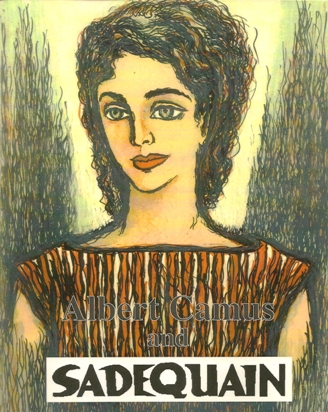 It was a remarkable achievement. An incredible scenario. How did Sadequain manage to impress the French jury to select him for the coveted assignment of pictorially interpreting the most famous novel written by the French Nobel Laureate, Albert Camus? France is a nation known to have more artists per square mile than any other country. Pakistan is a country not to have produced artists of international repute. Sadequain, a Pakistani, could not read or write French. Then how could he comprehend the intellectually taxing French novel based on the philosophical complexities of existentialism? If he could not read and understand it well enough then how could he illustrate its emotions, the irony, and the absurdity? The improbable achievement deserves a special treatment.
It was a remarkable achievement. An incredible scenario. How did Sadequain manage to impress the French jury to select him for the coveted assignment of pictorially interpreting the most famous novel written by the French Nobel Laureate, Albert Camus? France is a nation known to have more artists per square mile than any other country. Pakistan is a country not to have produced artists of international repute. Sadequain, a Pakistani, could not read or write French. Then how could he comprehend the intellectually taxing French novel based on the philosophical complexities of existentialism? If he could not read and understand it well enough then how could he illustrate its emotions, the irony, and the absurdity? The improbable achievement deserves a special treatment.
To facilitate the enormity of the task, this book provides a short background note on the Nobel Laureate, Albert Camus and a summary of his novel, The Stranger, written in 1942. This background note provides a perspective with respect to the collection of lithographs by Sadequain illustrating the characters and the story of the novel.
While residing part time in Paris during the 1960s, Sadequain was chosen to illustrate the novel, The Stranger, a significant achievement for a Pakistani artist by any measure. There are not many documents that record the sequence of events leading to the selection of Sadequain as the illustrator-designate of the classic novel. The only documented references are found in Sadequain’s letters written to his brother, Kaz-e-man, which were published in a book titled, Khutoot-e-Sadequaini.
In two separate letters dated January 29 and January 31 of 1964, Sadequain wrote about a significant event. He was visited by the representatives of a prominent publishing house that was planning to publish an exclusive and limited edition of the illustrated version of a novel, titled The Stranger, written by the French Nobel Laureate, Albert Camus. Several artists, including Sadequain were invited to submit their proposed sketches of the illustrations and interpretations of the novel. The representatives of the jury came in person to inform him of his selection as the chosen one to do the illustrations. “The representatives expressed desire to see samples of my work if that could be arranged in the next few days. On February 1, an exhibition of my paintings was hurriedly arranged at Galerie Lambert, the gallery that represented me at the time. It was more like a presentation rather than an exhibition because it was not open to the public,” Sadequain wrote.
In an upbeat letter of October 6, 1966, written from Hotel d’ Europe, 20 rue Roquepine, Paris, he wrote that The Stranger was finally ready for publication. It took extra time for completion because the first edition had to be destroyed because of quality issues. The inaugural reception was held on Thursday, October 27 at Place de la Concorde, number 6. The chief guest at the reception was Madame Camus. In a letter dated November 29, Sadequain wrote that the reception was very festive. It was attended by the cultural elite and widely covered in the art circles. Sadequain was treated like a celebrity, and spent much time signing autographs for the seekers. The organizers printed several hundred lithographic prints for sale and they were all sold quickly. Basking in success, Sadequain moved to a new address, a detached house located at 16 rue Madeline Michellis, Neuilly, Paris.
In one of his letters, Sadequain mentioned that he did 170 lithographs for The Stranger. It is not clear if there were 170 individual illustrations or that 170 lithographs of separate colors were produced and then superimposed to produce the final count that are reproduced in this book. In addition to the final color images, this book also includes several studies of The Stranger done in pencil.
The limited edition book, The Stranger was never available in Sadequain’s own country. His achievement has remained unknown to his own people until now. The SADEQUAIN Foundation has worked tirelessly to locate Sadequain’s work that he recklessly lost as fast as he produced it. For the first time, the lithographs of illustrations of The Stranger are now available to general public.